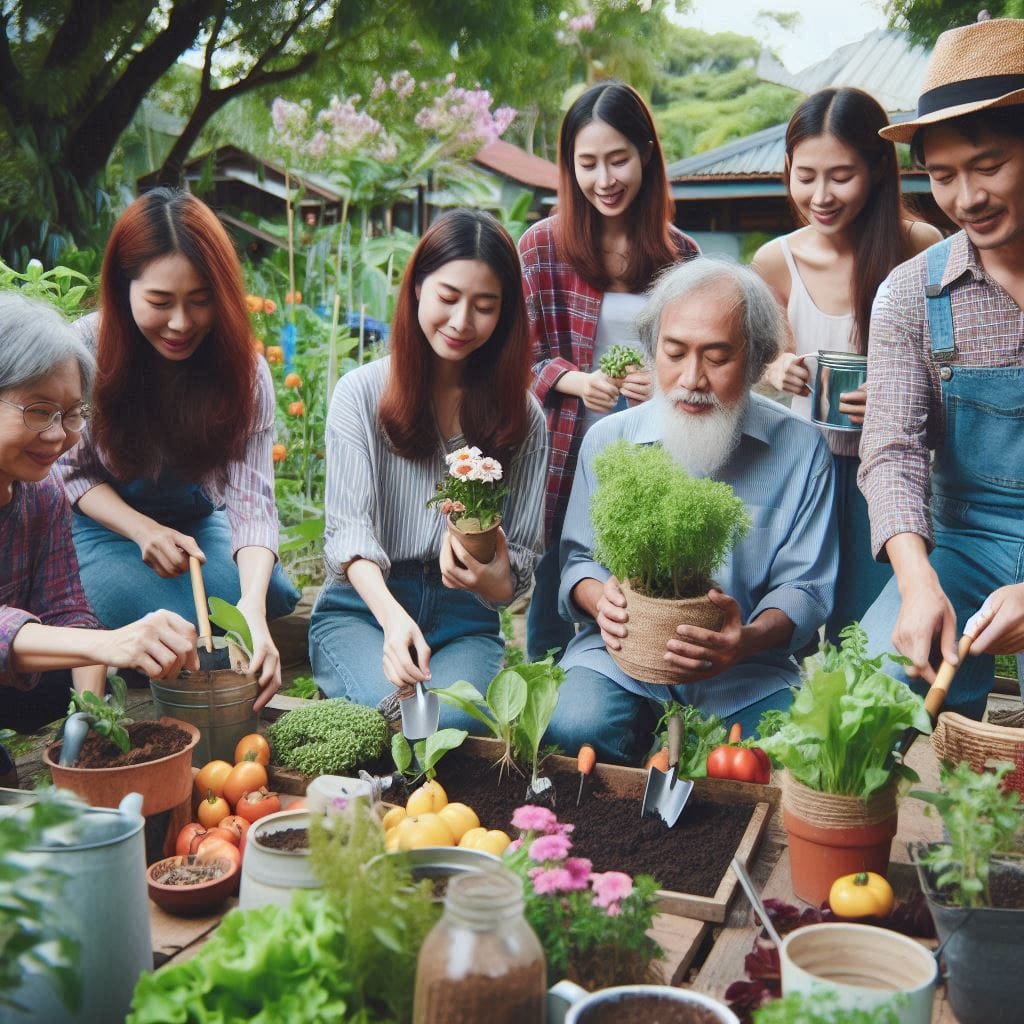Table of Contents
Organic gardening is a fantastic way to grow your own food while being kind to the environment. Whether you are new to gardening or have years of experience, this guide will provide you with practical tips and techniques to help you create a thriving, chemical-free garden. You’ll learn everything from soil health to pest control, ensuring your garden flourishes naturally.
Key Takeaways
- Learn the benefits of companion planting to naturally deter pests and enhance plant growth.
- Understand the importance of mulching to retain soil moisture and suppress weeds.
- Discover how to compost kitchen scraps and yard waste to create nutrient-rich soil.
- Explore effective organic methods for preventing and treating plant diseases.
- Implement sustainable gardening practices that conserve water and use renewable resources.
Essential Techniques for Organic Gardening

Companion Planting for Pest Control
Companion planting involves growing certain plants together to help each other out. This method can naturally keep pests away, attract helpful insects, and even make the soil better. For example, planting marigolds with tomatoes can deter nematodes, while basil can improve the flavor of tomatoes.
Mulching for Moisture Retention
Mulching is a simple way to keep your garden healthy. It helps the soil hold onto water, stops weeds from growing, and keeps the soil temperature steady. You can use things like straw, leaves, or grass clippings as mulch. This not only saves water but also makes your garden look neat.
Composting for Fertile Soil
Composting turns your kitchen scraps and yard waste into rich, dark soil that plants love. It’s like recycling for your garden. By adding compost to your soil, you give your plants the nutrients they need to grow strong and healthy. Plus, it’s a great way to reduce waste and help the environment.
Organic gardening is all about working with nature, not against it. By using these techniques, you can create a garden that’s both beautiful and sustainable.
Planning Your Organic Garden

Designing an Efficient Garden Layout
Creating a well-thought-out garden layout is essential for a thriving organic garden. Plan your garden in a way that maximizes sunlight exposure and optimizes space usage. Consider the mature size of plants and ensure taller plants do not shade shorter ones. Group plants with similar water and sunlight needs together to make maintenance easier.
Choosing the Right Plants
Selecting the right plants for your garden is crucial. Choose a variety of fruits, vegetables, and herbs that are well-suited to your climate and growing conditions. Opt for disease-resistant varieties to minimize the need for interventions. Rotate crops each season to prevent nutrient depletion and reduce the risk of soil-borne diseases.
Maximizing Space and Productivity
To make the most of your garden space, use techniques like vertical gardening and succession planting. Vertical gardening involves growing plants upwards using trellises, cages, or vertical planters, which is perfect for small spaces. Succession planting ensures a continuous harvest throughout the growing season by planting new crops as soon as old ones are harvested.
Thoughtful planning and smart plant choices can lead to a bountiful and healthy organic garden. By considering factors like sunlight, plant compatibility, and space optimization, you can create a garden that thrives naturally.
Soil Health and Fertility

Understanding Soil Composition
Healthy soil is the foundation of a thriving organic garden. Conducting a soil test helps you understand your soil’s nutrient content and pH level. This information is crucial for making informed decisions about soil amendments. Soil is typically composed of sand, silt, clay, and organic matter. Each type has its own characteristics:
- Sandy Soil: Drains quickly but doesn’t hold nutrients well.
- Clay Soil: Holds nutrients but drains poorly.
- Silty Soil: Fertile and holds moisture but can compact easily.
- Loamy Soil: Ideal for gardening, a balanced mix of sand, silt, and clay.
Natural Ways to Improve Soil Health
Improving soil health is essential for any garden. Adding organic matter like compost and natural fertilizers can significantly enhance soil quality. Compost, which is decomposed organic material, improves soil structure and boosts nutrient content. Natural fertilizers such as manure and bone meal introduce beneficial microorganisms that help aerate the soil and combat soil-borne diseases.
Testing and Amending Soil
A soil test provides valuable insights into your soil’s nutrient levels and pH. Based on the results, you may need to add amendments to improve soil quality. Common soil amendments include:
- Compost: Enhances soil structure and fertility.
- Manure: Adds essential nutrients.
- Peat Moss: Improves water retention.
- Perlite: Enhances soil aeration.
Regularly testing and amending your soil ensures a healthy growing environment for your plants.
Organic Disease Management

Preventing Common Plant Diseases
Preventing plant diseases in an organic garden starts with choosing disease-resistant plant varieties. This simple step can save you a lot of trouble down the line. Additionally, practice crop rotation to avoid soil-borne diseases and ensure your plants have enough space for air circulation, which helps prevent fungal infections.
Organic Treatments for Plant Ailments
When diseases do strike, organic treatments can come to the rescue. Neem oil, baking soda solutions, and compost teas are effective against many common plant ailments. These treatments are not only safe for your plants but also for the beneficial insects in your garden.
Maintaining Plant Health
Keeping your plants healthy is the best defense against diseases. Regularly inspect your plants for signs of trouble and remove any affected leaves or plants immediately. Healthy plants are less likely to succumb to diseases, so make sure they get the nutrients they need through organic fertilizers and proper watering practices.
A healthy garden is a happy garden. By focusing on prevention and using organic treatments, you can keep your plants thriving and disease-free.
Harvesting and Preserving Your Produce

Best Practices for Harvesting
For the best flavor and nutritional value, harvest your crops at their peak ripeness. Watch for visual cues like color changes and use all your senses — smell and touch can offer valuable information. Proper harvesting techniques ensure that fruits and vegetables are picked at their peak ripeness, maximizing flavor and nutritional value. Before enjoying the fruits of your labor, be sure to wash away any residual dirt or debris. A gentle rinse under running water will do for most produce, but firmer vegetables might benefit from a light scrub with a vegetable brush.
Techniques for Preserving Nutrients
To keep the nutrients in your produce, consider methods like freezing, canning, and drying. Freezing is one of the simplest ways to preserve your harvest and maintain its nutritional value. Canning, although more time-consuming, can store your produce for longer periods. Drying is another effective method, especially for herbs and fruits.
Storing Your Harvest for Longevity
Proper storage is key to extending the life of your produce. Root vegetables like carrots and potatoes can be stored in a cool, dark place. Leafy greens should be kept in the refrigerator, ideally in a crisper drawer. For fruits, consider their specific needs; apples, for example, store well in a cool environment, while bananas prefer room temperature.
Harvesting the fruits of your labor is not only gratifying but also serves as a tangible reminder of the time and effort invested in your garden.
Sustainable Garden Practices

Water Conservation Techniques
Conserving water is crucial for a sustainable garden. Use drip irrigation systems to deliver water directly to the roots, reducing evaporation. Collect rainwater in barrels to use during dry spells. Mulching also helps retain soil moisture, cutting down on the need for frequent watering.
Using Renewable Resources
Opt for renewable resources whenever possible. Compost kitchen scraps and garden waste to create nutrient-rich soil. Use organic fertilizers and natural pest control methods to keep your garden healthy without relying on synthetic chemicals.
Creating a Wildlife-Friendly Garden
Encourage biodiversity by creating habitats for beneficial insects, birds, and other wildlife. Plant native species that provide food and shelter. Avoid using pesticides that can harm these helpful creatures. A wildlife-friendly garden not only supports the ecosystem but also helps in natural pest control.
A sustainable garden is not just about growing plants; it’s about creating a balanced ecosystem that supports all forms of life.
Weed Management and Natural Pest Control

Organic Weed Control Methods
Weeds can be a major headache in any garden, but there are effective organic methods to keep them in check. Mulching is one of the best ways to suppress weeds while also conserving moisture in the soil. You can use organic materials like straw, leaves, or grass clippings as mulch. Another method is hand weeding, which, although labor-intensive, ensures that you remove the weeds from the root, preventing them from growing back.
Attracting Beneficial Insects
In organic gardening, beneficial insects are your allies. Ladybugs, lacewings, and praying mantises can help control pest populations naturally. Planting flowers like marigolds, sunflowers, and dill can attract these helpful insects to your garden. By creating a habitat that supports beneficial insects, you reduce the need for chemical pesticides.
Natural Pest Deterrents
There are several natural ways to deter pests from your garden. Neem oil, for example, is a natural pesticide that can be used to treat a variety of pests. Garlic and chili pepper sprays are also effective in keeping pests at bay. Additionally, planting pest-repellent plants like basil, mint, and rosemary can help protect your garden from unwanted visitors.
By using these organic methods, you can manage weeds and pests effectively while maintaining a healthy and balanced garden ecosystem.
Conclusion
Organic gardening is more than just a way to grow plants; it’s a partnership with nature that brings numerous benefits. By following the tips and techniques in this guide, you can create a garden that thrives without harmful chemicals. Whether you’re new to gardening or have years of experience, these methods will help you grow healthy, delicious produce while also caring for the environment. Embrace the journey of organic gardening and enjoy the rewards of fresh food, a beautiful garden, and a greener planet.
Frequently Asked Questions
What is organic gardening?
Organic gardening means growing plants without using synthetic chemicals. Instead, natural methods are used to keep the soil healthy and manage pests.
Why should I try organic gardening?
Organic gardening is better for the environment and your health. It helps reduce pollution and provides you with fresh, chemical-free produce.
How do I start an organic garden?
Begin by choosing a sunny spot and preparing the soil with compost. Select plants that are well-suited to your climate and follow organic practices like mulching and crop rotation.
What is companion planting?
Companion planting involves growing certain plants together to help each other. For example, some plants can repel pests that might harm their neighbors.
How can I improve the soil in my organic garden?
Use compost, mulch, and cover crops to add nutrients to the soil. Regularly testing your soil can also help you understand what it needs.
What are some natural ways to control pests in my garden?
You can attract beneficial insects like ladybugs, use natural repellents, and practice good garden hygiene to keep pests at bay.





